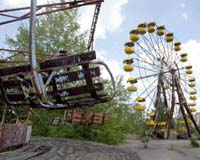 |
Moscow (AFP) April 25, 2011 The pilots who flew over Chernobyl to limit the danger from the destroyed reactor were aware of the risks despite huge radiation doses and inadequate safety precautions, their commander said Monday. In the 10 days after the world's worst nuclear disaster on April 26, 1986, Soviet pilots carried out 4,000 flights to dump thousands of tons of lead, sand and clay to cover the destroyed reactor four. In a rare interview with the Komsomolskaya Pravda daily published on the eve of the disaster's 25th anniversary, the then air force chief for the Kiev district General Nikolai Antoshkin gave a chilling insight into the risks. The pilots received potentially lethal doses of radiation that went completely off the scale of their dosimeters while precautions were as basic as changing uniforms, using cream and taking baths, he said. "Of course the pilots knew (they were getting high doses) and the consequences," Antoshkin, who was made a Hero of the Soviet Union, the highest award bestowed by the USSR, for his work in liquidating the disaster. "They said 'comrade general, this is not Afghanistan. There you are shot at but you turn back, land and forget. But here the enemy is invisible. How will this affect me, my children in the future?'" "But the pilots knew that the reactor needed to be covered as quickly as possible. You'd tell the pilot to leave but he'd come back." None of the estimated 600 pilots who took part are among the 28 people confirmed to have died of radition exposure in the months after the explosion, although two were killed in a helicopter crash over the reactor. However the extent of the health effects on the pilots and the half million other so-called "liquidators" remains hugely controversial, with estimates ranging from only a few dozen other deaths attributable to Chernobyl to tens of thousands. Antoshkin, who was responsible for coordinating the fly-overs in the crucial first 10 days after the explosion, said the teams took the best precautions they could in the circumstances. "Every day the crews changed their uniforms. They gave us iodine tablets and some kind of nasty anti-radiation cream from Leningrad for those who flew across the reactor. "We used whatever they proposed. Although we knew they were weak precautions. They forced the pilots to take baths to wash away the radioactive dirt." He said the extent of the danger was clear from the very first flight to dump sand on the reactor. "The device for measuring radiation could not cope. It's maximum level was 500 roentgen. I estimated that it would be 1,500 at that height. "And then I was told 'you deceived your pilots. It's 3,000-3,500 roentgen.' I said: 'What's the difference, whether 1,000 or 3,500, the task needs to be fulfilled'".
Share This Article With Planet Earth
Related Links Bringing Order To A World Of Disasters A world of storm and tempest When the Earth Quakes
 World remembers Chernobyl, haunted by nuclear fears
World remembers Chernobyl, haunted by nuclear fearsKiev (AFP) April 25, 2011 The world on Tuesday marks a quarter century since the world's worst nuclear disaster at Chernobyl in Ukraine, haunted by fears over the safety of atomic energy after the Japan earthquake. In the early hours of April 26, 1986, workers at the Chernobyl atomic power station were carrying out a test on reactor four when operating errors and design flaws sparked successive explosions. The ra ... read more |
|
| The content herein, unless otherwise known to be public domain, are Copyright 1995-2010 - SpaceDaily. AFP and UPI Wire Stories are copyright Agence France-Presse and United Press International. ESA Portal Reports are copyright European Space Agency. All NASA sourced material is public domain. Additional copyrights may apply in whole or part to other bona fide parties. Advertising does not imply endorsement,agreement or approval of any opinions, statements or information provided by SpaceDaily on any Web page published or hosted by SpaceDaily. Privacy Statement |